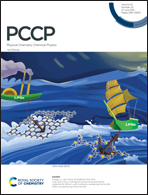The impact of insufficient time resolution on dye regeneration lifetime determined using transient absorption spectroscopy†
Abstract
Dye regeneration lifetimes of a combination of dyes and redox mediators were determined by two transient absorption (TA) spectrometers with 0.5 ns (sub-ns) and 6 ns (ns) time resolutions to elucidate the impact of insufficient time resolution on the measurements of dye regeneration kinetics in dye-sensitised semiconductor electrodes. Due to the disordered nature of the dye-sensitised electrodes, the dye regeneration lifetime is often characterised by half-decay time (τ1/2) of the initial signal magnitude. Alternatively, τ1/2,S is calculated from stretched-exponential lifetime (τww) and the distribution of lifetimes characterised by the stretch parameter (β). Stretched-exponential functions were numerically modelled, showing that to keep the error in τ1/2 ≤ 10%, τww needs to be at least 20 times longer than the time resolution in case of non-dispersive transients (β = 0.9) but at least 870 times longer when dispersive (β = 0.5). To test the predictions, TA decays of a combination of organic and porhyrin dyes and three cobalt-complex mediators are analysed, spanning a range of τww and β. These examples show that a 262% error in τ1/2 is possible if the time resolution of the TA setup is only 13 times faster than τww and smaller β results in larger error when τww is similar. Determining τ1/2,S by stretched-exponential fitting generally reduces the error compared to that determined directly from the graph. However, if the stretched-exponential function does not correctly describe the early signal transient, even a larger error by stretched-exponetial fitting is introduced. The key requirement for accurate measurement is to have a fast-enough TA setup to resolve the initial plateau of the TA signal. To demonstrate the impact of the measured errors, the measured regeneration lifetimes are plotted versus the driving force of the reaction and modelled using Marcus theory. Erroneous regeneration rates lead to an underestimated electronic coupling term by 2.2 times in case of a series of porphyrin dyes matched with Co complex electrolytes, a significant impact when the interpretation of factors affecting electron transfer at dye-sensitised semiconductor/electrolyte interface is discussed.

- This article is part of the themed collection: 2021 PCCP HOT Articles


 Please wait while we load your content...
Please wait while we load your content...